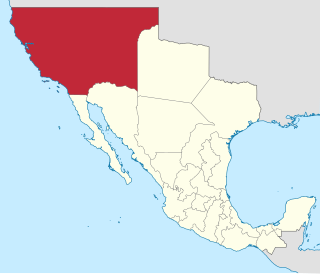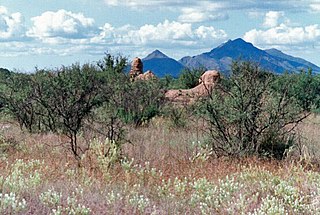Related Research Articles

Mission San Xavier del Bac is a historic Spanish Catholic mission located about 10 miles (16 km) south of downtown Tucson, Arizona, on the Tohono O'odham Nation San Xavier Indian Reservation. The mission was founded in 1692 by Padre Eusebio Kino in the center of a centuries-old settlement of the Sobaipuri O'odham, a branch of the Akimel or River O'odham located along the banks of the Santa Cruz River. The mission was named for Francis Xavier, a Christian missionary and co-founder of the Society of Jesus in Europe. The original church was built to the north of the present Franciscan church. This northern church or churches served the mission until it was razed during an Apache raid in 1770.

Alta California, also known as Nueva California among other names, was a province of New Spain formally established in 1804. Along with the Baja California peninsula, it had previously comprised the province of Las Californias, but was made a separate province in 1804. Following the Mexican War of Independence, it became a territory of Mexico in April 1822 and was renamed Alta California in 1824.
The Opata are an Indigenous people in Mexico. Opata territory, the "Opatería" in Spanish, encompasses the mountainous northeast and central part of the state of Sonora, extending to near the border with the United States. Historically, they included several subtribes, including the Eudeve, Teguima, and Jova peoples.

The Spanish missions in the Sonoran Desert are a series of Jesuit Catholic religious outposts established by the Spanish Catholic Jesuits and other orders for religious conversions of the Pima and Tohono O'odham indigenous peoples residing in the Sonoran Desert. An added goal was giving Spain a colonial presence in their frontier territory of the Sonora y Sinaloa Province in the Viceroyalty of New Spain, and relocating by Indian Reductions settlements and encomiendas for agricultural, ranching, and mining labor.

The Mayo or Yoreme are an Indigenous group in Mexico, living in the northern states of southern Sonora, northern Sinaloa and small settlements in Durango.

La Misión de San Gabriel de Guevavi was founded by Jesuit missionary priests Eusebio Kino and Juan María de Salvatierra in 1691. Subsequent missionaries called it San Rafael and San Miguel, resulting in the common historical name of Mission Los Santos Ángeles de Guevavi.

The Californias, occasionally known as the Three Californias or the Two Californias, are a region of North America spanning the United States and Mexico, consisting of the U.S. state of California and the Mexican states of Baja California and Baja California Sur. Historically, the term Californias was used to define the vast northwestern region of Spanish America, as the Province of the Californias, and later as a collective term for Alta California and the Baja California Peninsula.

Bacoachi is a small town in Bacoachi Municipality in the north of the Mexican state of Sonora. The area of the municipality is 487 square miles (1,260.65 km2) and the population was 1,456 in 2005, with 924 inhabitants residing in the municipal seat. The elevation of the municipal seat is 4,429 feet above sea level.

The Guarijío are an indigenous people of Mexico. They primarily live in 17 villages near the West Sierra Madre Mountains in Chihuahua and the Sonoran border. Their homelands are remote and reached either on foot or horseback. Their traditional Guarijio language has about 2100 speakers.

The Province of Las Californias was a Spanish Empire province in the northwestern region of New Spain. Its territory consisted of the entire U.S. states of California, Nevada, and Utah, parts of Arizona, Wyoming, and Colorado, and the Mexican states of Baja California and Baja California Sur.
Luis Xavier Velarde (1677–1737) was a Jesuit missionary to Mexico.
Custodio Ximeno was a Jesuit missionary to New Spain. He served at Mission Los Santos Ángeles de Guevavi from 1763 until the 1767 expulsion of the Jesuits from Mexico.
Jacobo Sedelmayr (1702–1779) was a Jesuit missionary in New Spain, known for his explorations of the Pimería Alta.
Daniel Januske was a Jesuit missionary in New Spain.
Alonso de Arrivillaga was a Jesuit missionary in New Spain.
Andrés Xavier García was a Jesuit missionary in New Spain.
Cristóbal de Cañas was a Jesuit missionary in New Spain.
Francisco Xavier Villarroya (1734–1768) was a Jesuit missionary to New Spain.
Gregorio Álvarez Tuñón y Quirós (1683–1728) was a presidio captain and alcalde mayor in New Spain. Historian John L. Kessell describes Tuñón y Quirós as a "provincial entrepreneur", while David Yetman says he was "widely known as the most corrupt official in the region".
References
- ↑ Schiavo, Giovanni Ermenegildo (1975). Italian-American History. Arno Press. p. 60. ISBN 978-0-405-06429-6.
- 1 2 Yetman, David (15 November 2010). The Ópatas: In Search of a Sonoran People. University of Arizona Press. p. 90. ISBN 978-0-8165-2897-4.
- ↑ Yetman, David (1 November 2012). Conflict in Colonial Sonora: Indians, Priests, and Settlers. UNM Press. ISBN 978-0-8263-5222-4.
- 1 2 Sheridan, Thomas E.; Polzer, Charles W. (1986). The Presidio and Militia on the Northern Frontier of New Spain: pt. 1. The Californias and Sinaloa-Sonora, 1700-1765. University of Arizona Press. p. 29. ISBN 978-0-8165-1692-6.
- ↑ Bancroft, Hubert Howe (1883). History of the Pacific States of North America: North American states. 1883. A.L. Bancroft. p. 246. Retrieved 6 May 2024.